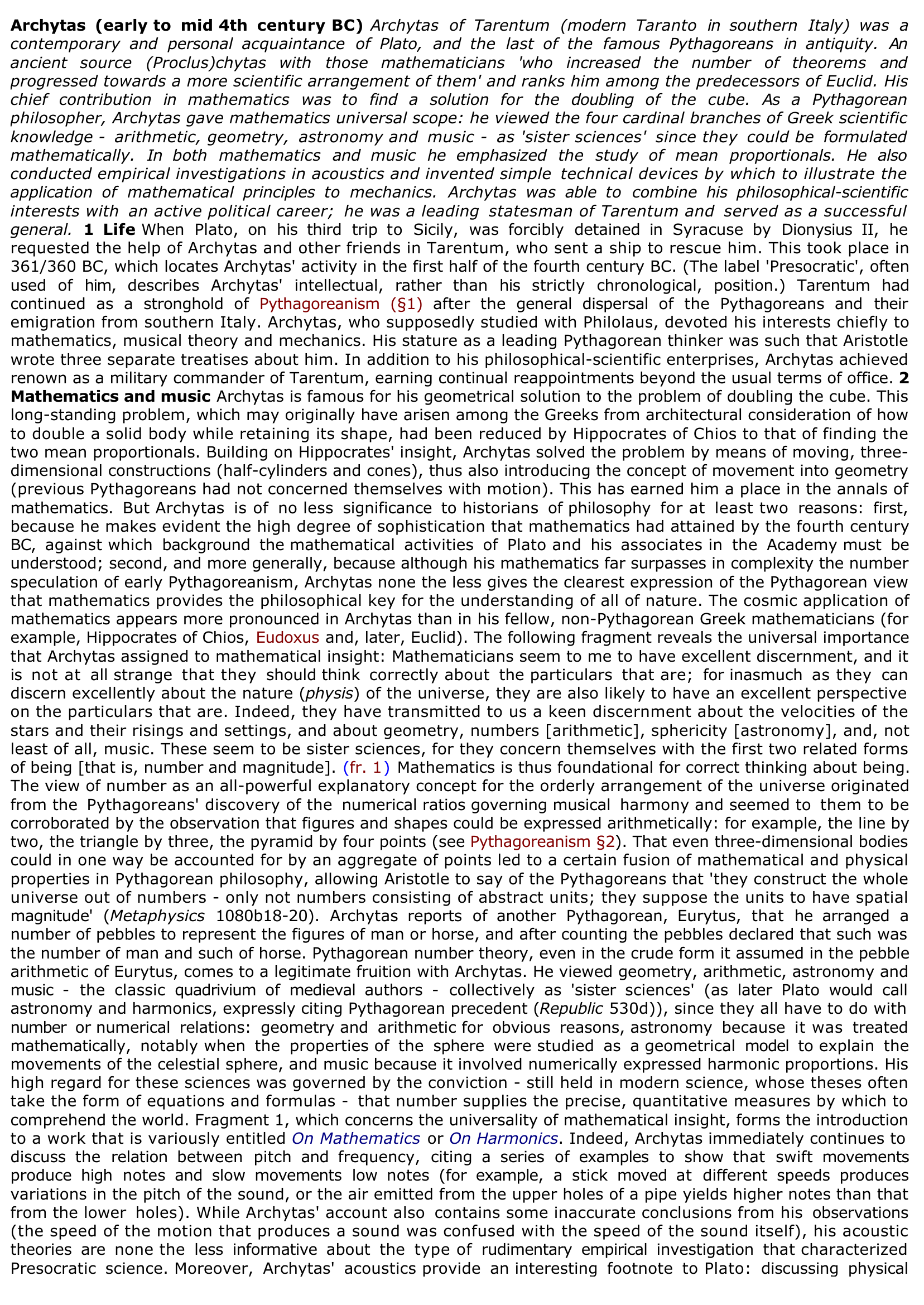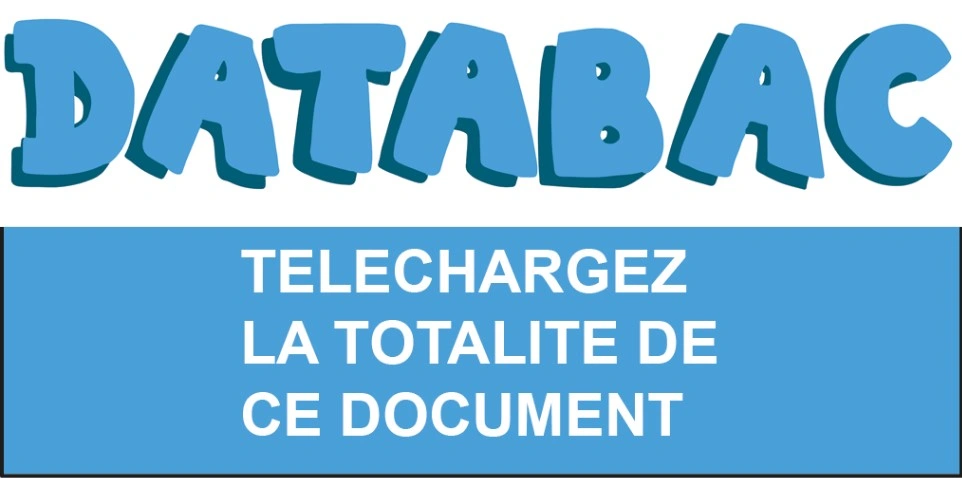Archytas
Publié le 16/05/2020
Extrait du document
«
Archytas (early to mid 4th century BC) Archytas of Tarentum (modern Taranto in southern Italy) was a contemporary and personal acquaintance of Plato, and the last of the famous Pythagoreans in antiquity.
Anancient source (Proclus)chytas with those mathematicians 'who increased the number of theorems andprogressed towards a more scientific arrangement of them' and ranks him among the predecessors of Euclid.
Hischief contribution in mathematics was to find a solution for the doubling of the cube.
As a Pythagoreanphilosopher, Archytas gave mathematics universal scope: he viewed the four cardinal branches of Greek scientificknowledge - arithmetic, geometry, astronomy and music - as 'sister sciences' since they could be formulatedmathematically.
In both mathematics and music he emphasized the study of mean proportionals.
He alsoconducted empirical investigations in acoustics and invented simple technical devices by which to illustrate theapplication of mathematical principles to mechanics.
Archytas was able to combine his philosophical-scientificinterests with an active political career; he was a leading statesman of Tarentum and served as a successfulgeneral.
1 Life When Plato, on his third trip to Sicily, was forcibly detained in Syracuse by Dionysius II, he requested the help of Archytas and other friends in Tarentum, who sent a ship to rescue him.
This took place in361/360 BC, which locates Archytas' activity in the first half of the fourth century BC.
(The label 'Presocratic', oftenused of him, describes Archytas' intellectual, rather than his strictly chronological, position.) Tarentum hadcontinued as a stronghold of Pythagoreanism (§1) after the general dispersal of the Pythagoreans and their emigration from southern Italy.
Archytas, who supposedly studied with Philolaus, devoted his interests chiefly tomathematics, musical theory and mechanics.
His stature as a leading Pythagorean thinker was such that Aristotlewrote three separate treatises about him.
In addition to his philosophical-scientific enterprises, Archytas achievedrenown as a military commander of Tarentum, earning continual reappointments beyond the usual terms of office.
2 Mathematics and music Archytas is famous for his geometrical solution to the problem of doubling the cube.
This long-standing problem, which may originally have arisen among the Greeks from architectural consideration of howto double a solid body while retaining its shape, had been reduced by Hippocrates of Chios to that of finding thetwo mean proportionals.
Building on Hippocrates' insight, Archytas solved the problem by means of moving, three-dimensional constructions (half-cylinders and cones), thus also introducing the concept of movement into geometry(previous Pythagoreans had not concerned themselves with motion).
This has earned him a place in the annals ofmathematics.
But Archytas is of no less significance to historians of philosophy for at least two reasons: first,because he makes evident the high degree of sophistication that mathematics had attained by the fourth centuryBC, against which background the mathematical activities of Plato and his associates in the Academy must beunderstood; second, and more generally, because although his mathematics far surpasses in complexity the numberspeculation of early Pythagoreanism, Archytas none the less gives the clearest expression of the Pythagorean viewthat mathematics provides the philosophical key for the understanding of all of nature.
The cosmic application ofmathematics appears more pronounced in Archytas than in his fellow, non-Pythagorean Greek mathematicians (forexample, Hippocrates of Chios, Eudoxus and, later, Euclid).
The following fragment reveals the universal importance that Archytas assigned to mathematical insight: Mathematicians seem to me to have excellent discernment, and itis not at all strange that they should think correctly about the particulars that are; for inasmuch as they candiscern excellently about the nature ( physis ) of the universe, they are also likely to have an excellent perspective on the particulars that are.
Indeed, they have transmitted to us a keen discernment about the velocities of thestars and their risings and settings, and about geometry, numbers [arithmetic], sphericity [astronomy], and, notleast of all, music.
These seem to be sister sciences, for they concern themselves with the first two related formsof being [that is, number and magnitude].
(fr.
1 ) Mathematics is thus foundational for correct thinking about being. The view of number as an all-powerful explanatory concept for the orderly arrangement of the universe originatedfrom the Pythagoreans' discovery of the numerical ratios governing musical harmony and seemed to them to becorroborated by the observation that figures and shapes could be expressed arithmetically: for example, the line bytwo, the triangle by three, the pyramid by four points (see Pythagoreanism §2 ).
That even three-dimensional bodies could in one way be accounted for by an aggregate of points led to a certain fusion of mathematical and physicalproperties in Pythagorean philosophy, allowing Aristotle to say of the Pythagoreans that 'they construct the wholeuniverse out of numbers - only not numbers consisting of abstract units; they suppose the units to have spatialmagnitude' ( Metaphysics 1080b18-20).
Archytas reports of another Pythagorean, Eurytus, that he arranged a number of pebbles to represent the figures of man or horse, and after counting the pebbles declared that such wasthe number of man and such of horse.
Pythagorean number theory, even in the crude form it assumed in the pebblearithmetic of Eurytus, comes to a legitimate fruition with Archytas.
He viewed geometry, arithmetic, astronomy andmusic - the classic quadrivium of medieval authors - collectively as 'sister sciences' (as later Plato would callastronomy and harmonics, expressly citing Pythagorean precedent ( Republic 530d)), since they all have to do with number or numerical relations: geometry and arithmetic for obvious reasons, astronomy because it was treatedmathematically, notably when the properties of the sphere were studied as a geometrical model to explain themovements of the celestial sphere, and music because it involved numerically expressed harmonic proportions.
Hishigh regard for these sciences was governed by the conviction - still held in modern science, whose theses oftentake the form of equations and formulas - that number supplies the precise, quantitative measures by which tocomprehend the world.
Fragment 1, which concerns the universality of mathematical insight, forms the introductionto a work that is variously entitled On Mathematics or On Harmonics .
Indeed, Archytas immediately continues to discuss the relation between pitch and frequency, citing a series of examples to show that swift movementsproduce high notes and slow movements low notes (for example, a stick moved at different speeds producesvariations in the pitch of the sound, or the air emitted from the upper holes of a pipe yields higher notes than thatfrom the lower holes).
While Archytas' account also contains some inaccurate conclusions from his observations(the speed of the motion that produces a sound was confused with the speed of the sound itself), his acoustictheories are none the less informative about the type of rudimentary empirical investigation that characterizedPresocratic science.
Moreover, Archytas' acoustics provide an interesting footnote to Plato: discussing physical.
»
↓↓↓ APERÇU DU DOCUMENT ↓↓↓

































